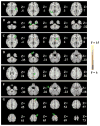Is aberrant functional connectivity a psychosis endophenotype? A resting state functional magnetic resonance imaging study
- PMID: 23746539
- PMCID: PMC3752322
- DOI: 10.1016/j.biopsych.2013.04.024
Is aberrant functional connectivity a psychosis endophenotype? A resting state functional magnetic resonance imaging study
Abstract
Background: Schizophrenia and bipolar disorder share overlapping symptoms and risk genes. Shared aberrant functional connectivity is hypothesized in both disorders and in relatives.
Methods: We investigated resting state functional magnetic resonance imaging in 70 schizophrenia and 64 psychotic bipolar probands, their respective first-degree relatives (n = 70 and 52), and 118 healthy subjects. We used independent component analysis to identify components representing various resting state networks and assessed spatial aspects of functional connectivity within all networks. We first investigated group differences using five-level, one-way analysis of covariance (ANCOVA), followed by post hoc t tests within regions displaying ANCOVA group differences and correlation of such functional connectivity measures with symptom ratings to examine clinical relationships.
Results: Seven networks revealed abnormalities (five-level one-way ANCOVA, family-wise error correction p < .05): A) fronto-occipital, B) midbrain/cerebellum, C) frontal/thalamic/basal ganglia, D) meso/paralimbic, E) posterior default mode network, F) fronto-temporal/paralimbic and G) sensorimotor networks. Abnormalities in networks B and F were unique to schizophrenia probands. Furthermore, abnormalities in networks D and E were common to both patient groups. Finally, networks A, C, and G showed abnormalities shared by probands and their relative groups. Negative correlation with Positive and Negative Syndrome Scale negative and positive scores were found in regions within network C and F respectively, and positive correlation with Positive and Negative Syndrome Scale negative scores was found in regions in network D among schizophrenia probands only.
Conclusions: Schizophrenia, psychotic bipolar probands, and their relatives share both unique and overlapping within-network brain connectivity abnormalities, revealing potential psychosis endophenotypes.
Keywords: Bipolar; endophenotype; relatives; resting state; schizophrenia; within-network connectivity.
Copyright © 2013 Society of Biological Psychiatry. Published by Elsevier Inc. All rights reserved.
Conflict of interest statement
Other authors report no biomedical financial interests or potential conflicts of interest.
Figures


References
-
- Greene T. The Kraepelinian dichotomy: the twin pillars crumbling? Hist Psychiatry. 2007;18:361–379. - PubMed
-
- Goodwin FK, Jamison KR. Manic-Depressive Illness. New York, NY: Oxford University Press; 2007. pp. 54–59.
Publication types
MeSH terms
Grants and funding
- MH78113/MH/NIMH NIH HHS/United States
- MH077945-03/MH/NIMH NIH HHS/United States
- MH077862/MH/NIMH NIH HHS/United States
- R01 EB006841/EB/NIBIB NIH HHS/United States
- MH077851/MH/NIMH NIH HHS/United States
- 2R01 EB000840/EB/NIBIB NIH HHS/United States
- R01 EB000840/EB/NIBIB NIH HHS/United States
- R01 MH077851/MH/NIMH NIH HHS/United States
- P20 RR021938/RR/NCRR NIH HHS/United States
- R01 MH074797/MH/NIMH NIH HHS/United States
- R01 MH077945/MH/NIMH NIH HHS/United States
- R01 EB020407/EB/NIBIB NIH HHS/United States
- R37 MH043775/MH/NIMH NIH HHS/United States
- R01 MH077862/MH/NIMH NIH HHS/United States
- R01MH074797/MH/NIMH NIH HHS/United States
- 5P20RR021938/RR/NCRR NIH HHS/United States
- R01 MH078113/MH/NIMH NIH HHS/United States
- R37MH43375/MH/NIMH NIH HHS/United States
LinkOut - more resources
Full Text Sources
Other Literature Sources
Medical

